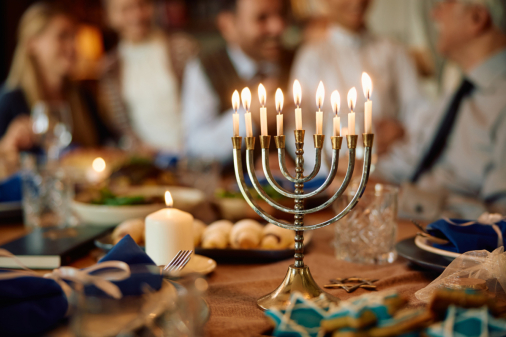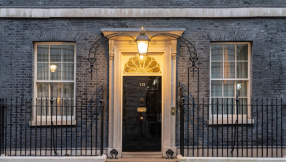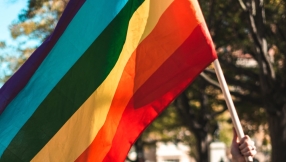
The Jewish festival of Hannukah, which this year runs from 25 December to 2 January, actually has a lot in common with the Christian Christmas. This is the story ...
Hanukkah Menorah
Hannukah is an annual Jewish festival which lasts eight days and is also known as the Festival of Lights, or the Feast of Dedication. During Hanukkah Jews light a nine-branched candelabra, called a Menorah, from the Hebrew word for lamp, which they often put in their window to be seen from the street.
This menorah is symbolic of the seven-branched oil lamp, which was in the Temple in Jerusalem (Exodus 25:31-40). The original Temple menorah was lit daily by a priest from fresh consecrated olive oil, and was never supposed to be allowed to go out (Exodus 27:21). The Talmud forbids a seven-branched menorah from being used outside the Temple, so the tradition arose for the Hanukkah menorah to have eight branches, plus a ninth lamp in the middle which is used to light the others.
History of Hanukkah
The background to Hanukkah lies in the second century BC when a Greek army led by King Antiochus IV Epiphanes (who ruled 175 to 164 BC) marched into Jerusalem (2 Maccabees 5:11–14). Antiochus banned Jewish worship, and attempted to force the inhabitants to worship Greek pagan gods instead. In 167 BC, he desecrated the Temple when he erected an altar in it to the pagan god Zeus (1 Maccabees 1:41-48), and let the Menorah go out. These insults triggered a Jewish revolt (1 Maccabees 1:62-64) by brothers of the priestly Hasmonean family (1 Maccabees 2). They became known as the Maccabees, thought to be derived from the Aramaic word for hammer.
There was a triumphal entry into Jerusalem by Simon Maccabee who came into Jerusalem to liberate it (1 Maccabees 13:51). Following the liberation of Jerusalem, the Jewish community cleansed the Temple from pagan worship in 164 (or 165) BC, led by Judah Maccabee (Judas Maccabeus) and his brothers (1 Maccabees 4:41-51). When the temple was ready, they ceremonially lit the menorah. The legend (whether true or not) goes that there appeared to be only just enough oil to keep it burning for a single day. However, this small quantity of oil kept the candle burning for eight days, which was the amount of time it took for more oil to be made. This was considered a miracle.
Hanukkah is inaugurated
Then "all the assembly of Israel determined that every year at that season the days of dedication of the altar should be observed with joy and gladness for eight days, beginning with the twenty-fifth day of the month of Chislev" (1 Maccabees 4:59).
Thus the Jewish Feast of Dedication was inaugurated. It is now better known as Hanukkah (also spelt Chanukah), from the Hebrew word for "dedication". The Jewish month of Chislev (also spelt Kislev), roughly equates to December. Hanukkah is a tradition for most Jewish groups around the world. Customs vary but a common custom is to light a menorah, also called a "hanukkiah", with one candle for each of the eight days of the miracle. A ninth candle in the middle is used to kindle the others.
Hanukkah in the Bible
Hanukkah is not mentioned in the modern form of the Jewish Bible, commonly called the Tanakh, which is based on the Masoretic Hebrew text. However, the story is told in the books of Maccabees. Key references are found in 1 Maccabees 4:36, 52–59 and in 2 Maccabees 1:18 and 10:5.
The books of Maccabees were included in the Septuagint, the Greek translation of the Jewish Bible widely used by diaspora Jews from the third century BC until the early centuries of the Christian era. The Septuagint was also the Old Testament for the Early Church, when Greek was the lingua franca. So, the books of Maccabees were effectively in the historical Bible for both Jews and Christians. These books are omitted in most modern Jewish and Protestant Bibles, although they remain in the Old Testament in Catholic and Christian Orthodox Bibles. However, Jews still reference this story in Maccabees at Hanukkah.
Jesus and Hanukkah
As was the custom at the time, Jesus marked Hanukkah. There is a reference in the New Testament to Jesus attending Hanukkah in John 10:22. The King James Version reads: "And it was at Jerusalem the feast of the dedication, and it was winter." The New International Version (NIV) adds in a helpful footnote to explain that the Feast of Dedications is Hanukkah. A few versions, which are happy to translate the meaning of words and phrases, rather than literally translate the words themselves, have translated Feast of Dedication as Hanukkah, as it is more commonly known today. The New Living Translation (NLT) has, "It was now winter, and Jesus was in Jerusalem at the time of Hanukkah, the Festival of Dedication." The EasyEnglish version, which was translated for people who do not have English as their first language, puts it as, "It was the time for the Jewish Festival called Hanukkah. This happened in Jerusalem. It was winter."
When Jesus himself made a triumphal ride into Jerusalem it echoed the liberation by the Maccabees. He followed this by cleansing the Temple, which echoed the cleansing of the Temple by the Maccabees at Hanukkah. Hanukkah is also known as the Festival of Lights when the Temple was rededicated, and at Christmas Christians recall that Jesus called himself the light of the world (John 8:12). This analogy with Hanukkah, when the Temple was rededicated, is stronger when we recall that Jesus also referred to himself as the new Temple (John 2:18–22).
It was at this Hanukkah that "Jesus was in the temple courts walking in Solomonʼs Colonnade. The Jews who were there gathered round him, saying, 'How long will you keep us in suspense? If you are the Messiah, tell us plainly.' Jesus answered, 'I did tell you, but you do not believe..." (John 10:23-25 NIV).
Early English Bible translations used to cross-reference John 10:22 to Maccabees. William Tyndale was the first to do this in his 1534 New Testament, which cross-references John 10:22 to 1 Maccabees 4. The original version of the King James Version from 1611 referenced John 10:22 to 1 Maccabees 4:59. Many modern English translations which seem squeamish about cross-referencing the Apocrypha do not add in this helpful reference, so the link is lost on most evangelical Christians.
The dating of Hanukkah and Christmas
The dating of Christmas has long been debated. Some people think it was to replace the longheld pagan winter solstice held in Britain. However, the first recorded references to Christmas predate Yule in Britain, and predate the arrival of St Augustine in England in the sixth century, so this theory does not make sense historically.
Hanukkah falls every year on the 25th day of the Jewish month of Kislev (also spelt Chislev), which overlaps with December, and Christmas falls on the 25th day of December. This may be one reason why early Christians adopted 25 December for Christmas. Each year Hanukkah falls around Christmas time. Some years the start of Hanukkah and Christmas fall on the same day. In 2024, the sunset of December 25 coincides with the 25th day of Kislev, the first night of Hanukkah, making Christmas Day and the beginning of Hanukkah fall on the same day.
The majority of the first Christians were from a Jewish background, and Hanukkah was part of their tradition. Just as the Passover was replaced by Easter, so it seems that Hanukkah was replaced by Christmas.
Candles
In nineteenth-century Germany when large numbers of Ashkenazi Jews and Christians lived alongside each other, the tradition of the Hanukkah Menorah may have influenced the Christian idea of the Advent candles. Lutheran Christians instead developed the idea of lighting Advent candles. The Advent wreath with five candles has been adopted now in many churches, when they light a candle for each Sunday in Advent and one central candle for Christmas. These days some Christians will also have a Menorah candle in the window.
Modern Hanukkah
Until modern times Hanukkah was a fairly minor Jewish festival. However, in countries where Jews and Christians have lived among each other, Hanukkah has developed to include many customs and practices of the wider community which are common at Christmas time, and they have adapted them to Hanukkah. As a result, Jews may sing Hanukkah songs, exchange gifts, send Hanukkah cards and attend Hanukkah parties. Some Jews even have a Hanukkah bush. The Hanukkah bush will usually have a star of David on top of the tree.
The many connections between Hanukkah and Christmas are more than a coincidence.













